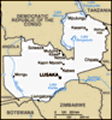Advertisement
Published: October 16th 2014
Southern Sun Garden Court Tambo Hotel, Zambia--Monday, March 31
th I am not sure why it was necessary, but this morning there is a tour scheduled to see Victoria Falls at 9:00. Valerie and I decided that where they planned to walk along the wet stone path was too slippery for the two of us, so we wandered down to look at the Falls on our own. The web page that we had looked at about the hotel we were staying in gave you the sense that you were so close to the Falls, that you could see them from our rooms or at least the reception area. Wrong! The Falls are about 2 blocks from the room–one block still on the hotel property and one more block after you leave the hotel/Reserve gate.
We walked out to a couple of overlooks and the Falls are lovely, spectacular, etc. with all kinds of rainbows arcing overhead, but they are so wide, you can only see part of the way across from standing on the side. More than five hundred million cubic meters of the Zambezi River, per minute, spread over a width of nearly 1 and 1/4 miles, plummet over
the edge into a gorge over 328 feet deep below. (Look for videos at
https://www.facebook.com/video.php?v=10204757788485904&set=vb.1273183320&type=3,
https://www.facebook.com/video.php?v=10204758294018542&set=vb.1273183320&type=3,
https://www.facebook.com/video.php?v=10204757872247998&set=vb.1273183320&type=3, and
https://www.facebook.com/video.php?v=10204758804311299&set=vb.1273183320&type=3)
So, we are a bit disappointed. They are so full with all the rain, that the mist billows up high in the air like smoke and covers everything. The midst looks so much like smoke that that is what the Natives named the Falls originally— ‘Mosi-oa-Tunya’ – The Smoke that Thunders. Everyone that walked down along the front path said they mostly saw mist and were soaked by the time they made their way back up.
Forgetting the unusually high river volume at this time of year, the greatest impediment for a complete view is the fact that the falls hurl straight down into a deep, narrow, rock gorge and there are two or three similar gorges in front of the Falls, open in the middle only for the width of the river to flow through. There is nothing in the way at Niagara Falls on the New York State/Canadian border and you only see the river falling to the river below. So, we learned that we needed to be in Zimbabwe on the other side, or take a
lighter than air plane or a helicopter flyover to really get the full effect, but even then I doubt we would get a clear view with the mist the way it was.
On our way back to our room we stopped at a bird hide and watched a good size flock of Village Weavers going in and out of their nests. This was a pretty spot, on a small pond, with giant water lilies growing in it. The boardwalk to a tiny island had very interesting metal handrails that made an interesting shadow “picture/design” on the boards. As we were getting ready to leave, a small group of baboons walked behind the blind.
After lunch, we loaded into the vans and departed for a tour of the native Mukuni Village. Philosophically, I have mixed feelings about touring places that people are still living in. Our group was respectful of the cultural differences and I understand that the money from tourists visiting are a big source of the village’s income; however, I don’t wish the villagers to think, we think, that their way of living is a “freak show” or something of that nature. I do recognize that this
is an opportunity to see how the local people live in a working village, not one built for tourists to gawk at.
Our guide was a woman who was born, grew up, and currently lives here. She met the tour buses and walked us around the compound. She told us that approximately 6,000 Toka-Leya people live in her village. That the village itself has been around since the 11
th century.
Dr. David Livingstone explored this area and visited this village to talk with their Chief on a couple occasions. He saw and named Victoria Falls after Queen Victoria. Two men from this group were his faithful attendants on his travels and carried his body after he died to the coast (over 1000 miles), so his body could be returned home. He is buried in Westminster Abby in London, England.
She showed us how traditional huts are built and decorated. We noticed a different type of top “cap” on the thatched roofs from those of the Zulu or Swaziland people. Each hut seemed to have a small individual family garden and was planted with various crops. We saw okra, beans, pumpkins, corn, peanuts, and herbs used for medicinal
purposes. We looked inside the compound and huts of one of the woman and her family.
The guide walked us by several men who were doing woodworking/carving and sold their wares in the village craft shop. She showed us and was quite proud of the community water faucet that people get their water from. We noticed the plethora of different water containers, some not as clean as we would have wished ours to be. None had lids or tops on them.
She showed us some of the trees planted in the village that are used for medicine and bear fruit that is eaten. One tree, the African Marula tree bears fruit that is processed into an oil and Amarula, a cream liquor. And lastly, she went by a group of young girls who were playing a game of keep-away with a “ball” made of cloth wrapped/tied with string. We all watched them for a while before heading to look at the craft shops.
Advertisement
Tot: 0.68s; Tpl: 0.016s; cc: 8; qc: 54; dbt: 0.3281s; 1; m:domysql w:travelblog (10.17.0.13); sld: 1;
; mem: 1.2mb























